The Georgian Military Highway or 'bottleneck' of the Caucasus?
Main route from Georgia to Russia
In the north of Georgia, in the snow-capped mountains, there is a road which has connected the countries of the South Caucasus with Russia for centuries.
The section of the road from Tbilisi to the Verkhniy Lars checkpoint on the Russian-Georgian border, historically called the Georgian Military Highway, is today the only land highway connecting Georgia with Russia. It is vital for Armenia and also important for other countries in the region – Turkey and Azerbaijan.
However, from autumn to spring the area becomes rather dangerous – heavy snowfall can block traffic at any time, avalanches are common and thousands of truck drivers or tourists get stuck in the cold. In summer, traffic is also difficult due to the large flow of tourists and occasional mudflows.
What are the prospects for the main highway of the South Caucasus?
Due to its geographical location, Georgia is the most important transit country in the region, connecting the countries of Central Asia with Europe. Cargoes through Georgia and from Georgia are transported by sea, rail and road.
Highways account for 59 percent of the country’s freight traffic, which is about 17.2 million tons per year.
- Armenia, Azerbaijan agree on transport corridors –what’s changing for Georgia?
- Trans-Caucasus railway: Moscow-Sukhum/i-Tbilisi-Yerevan – no beginning, no end
- Historic Shatili village – how Georgia’s mountains have emptied of people
The length of international transit roads in Georgia is 1,467 kilometers. One of the most important of them is the Mtskheta-Stepantsminda-Upper Lars road, which connects Georgia with Russia.
Of the 315,500 cars that drove on the roads of Georgia in 2020, up to 45 percent drove on the Georgian Military Highway.
This is the only active land road from Georgia to Russia, since alternative routes – through Abkhazia and South Ossetia – have been closed for many years due to conflicts.
This path is no less important for Armenia, which, with its help, is connected with its most important economic and political partner – Russia. 60-70 percent of all transit of goods for Armenia are carried out through the territory of Georgia.
Most often, wheat, other food products and building materials from Russia are imported to Georgia and Armenia along this road.
Wine is brought from Georgia to Russia, cognac, wine materials, fruits from Armenia. Industrial goods from Turkey are delivered to Russia along this road.
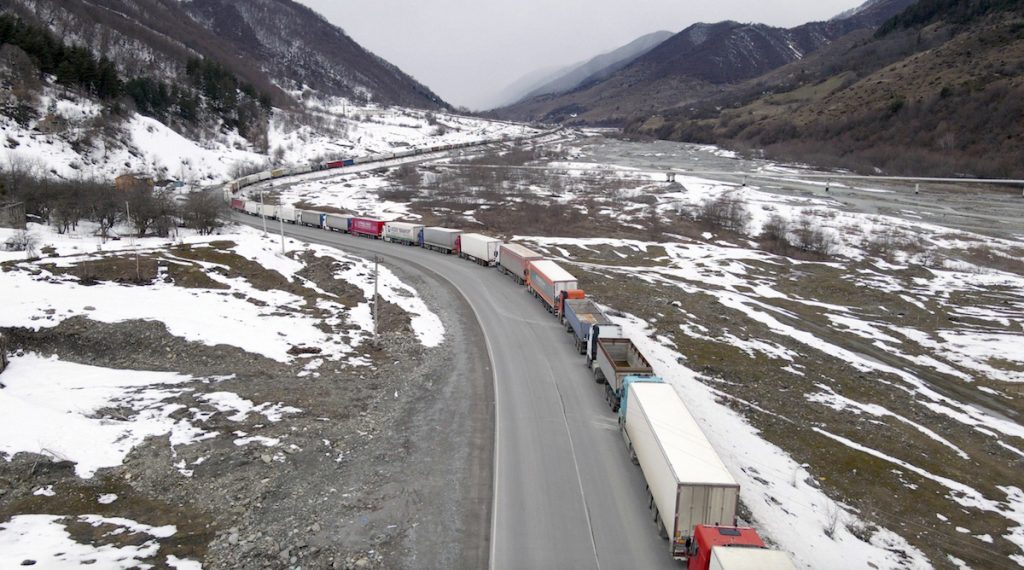
Several thousand transit vehicles move along this road every day and their number has not decreased even during the pandemic.
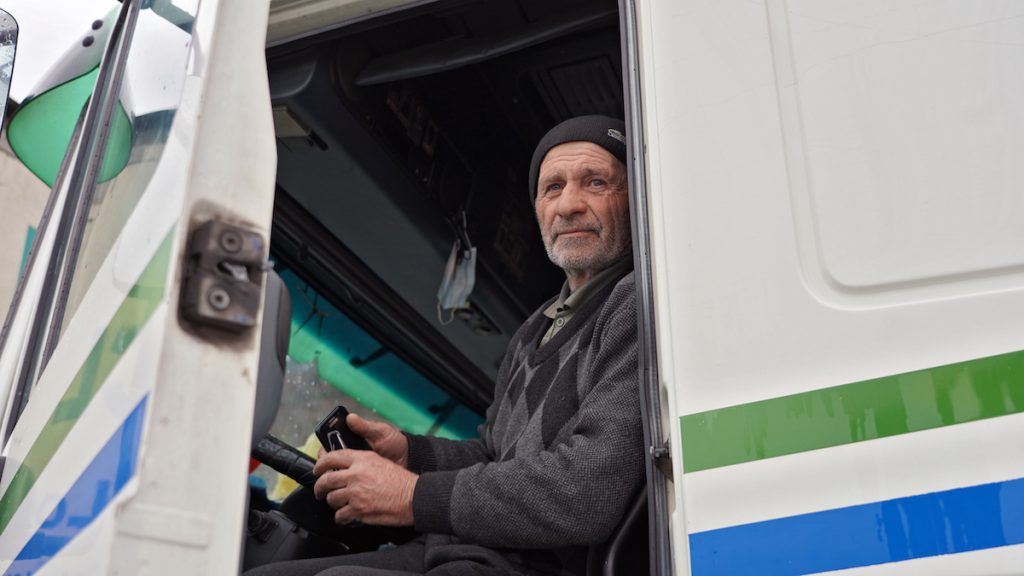
38-year-old Alexander is from Belarus. He works as a trucker. The last time he loaded a car in Russia with hygiene products and delivered the cargo through Georgia to Armenia.
On the way back, Alexander drives empty. The car will be loaded again in Russia and this time it will go to Poland.
However, the road to Lars was closed due to bad weather, which changed his plans.
“I have been standing here for four days. I sleep in the car, eat in the car. Before that, I stood near Tbilisi for four nights. They stop us there so as not to load the road here. Who should I ask? I dont know. I’m waiting for the police to come and say that we can move on. But my business suffers from this,”he says.
Hundreds of trucks lined up on the road from Tbilisi to the north, starting from the village of Pasanauri. Day and night, they stand on the side of the road, forming a huge column that impedes the movement of cars.
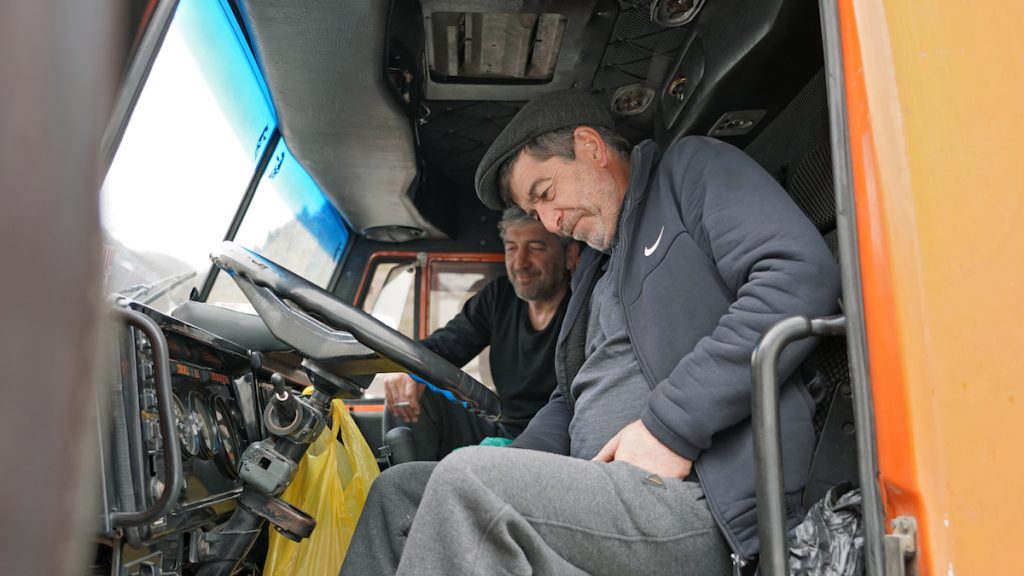
The movement of trucks in winter and summer is regulated by the patrol police. If they were all moving along this narrow road at the same time, traffic would be nearly impossible for cars, tourists and locals.
Now drivers have been standing in one place for several days due to heavy snowfall. They sleep and eat in their trucks. To pass the time, they sometimes go out and talk to each other.
Some of them are already accustomed to such waiting and are well prepared: one of the drivers washes right on the road in front of his own car with the help of a small bucket.
Drivers complain that Lars is an inconvenient route due to such delays, but at the moment there is no alternative to it.
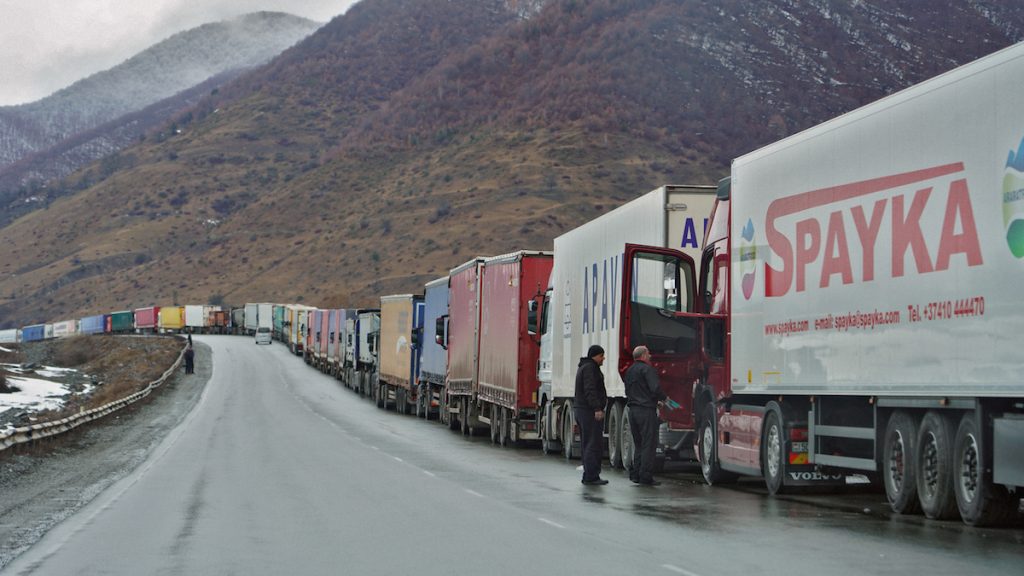
However, experts say that the problem is not only the impassability of the road and climatic conditions.
Paata Tsagareishvili, director of the Georgian Transport Corridor Research Center, claims that the narrowest point on this route is a checkpoint on the Russian side.
“Russian customs can handle only 400 trucks a day, and sometimes 800-1000 vehicles pass here. Despite heavy traffic on the roads, Russian customs are not expanded. The solution to this problem depends entirely on Russia. In this case, Georgia will not be able to do anything,” the expert says.
A new road – a solution to the problem?
While Georgia has every opportunity to be a leading transit country, according to a study by Tbilisi State University, Georgia is not using this opportunity appropriately.
According to the Logistics Performance Index developed by the World Bank, in 2018 Georgia ranked 119th out of 160 countries by this criterion.
Until recently, Georgia was the uncontested transit hub in the region, but following the second Karabakh war everything can change; an agreement was reached in Moscow according to which Armenia and Azerbaijan agreed to open previously closed transit corridors. This means that alternative routes will appear in the region, which could weaken the transit importance of Georgia.

Dean of the business school of the Tbilisi Free University Giga Bedineishvili does not consider this issue to be dramatic.
“Competition will grow, but in this we have never been a monopolist. How effectively we use Georgia’s transit opportunities is a more important question.
Geographic advantage alone does not provide commercial benefits, we must effectively use our capabilities and make the railroad, which is now a loss-making company, profitable.”
In this context, the new section of the road, which is being built on the Tbilisi-Lars section, is becoming even more important to ensure uninterrupted transit traffic at any time of the year.
A two-lane asphalt concrete road with a length of 22.7 kilometers, connecting the villages of Kvishkheti and Kobi on opposite sides of the Main Caucasian ridge, will make it possible to bypass the avalanche-prone pass using a nine-kilometer tunnel.
The road will cross six bridges and five tunnels, which will shorten the route along this section by a total of 12 kilometers. To travel along this road, instead of an hour, as it is now, it will take 20 minutes.
The construction of this road, which the Georgian authorities have called a “historical project”, began in 2019 and should be completed in 2023.
The idea to build a tunnel here arose back in the 1970s, during the Soviet Union. This idea was remembered during the reign of President Shevardnadze, in 1997, but the project then did not start, mainly due to lack of funds.
During a trip to the border town of Kazbegi in 2012, President Mikheil Saakashvili promised local residents to build a large tunnel to “turn Kazbegi into a small suburb of Tbilisi.”
The project cost is USD 558 million. It is financed with loans from the Asian Development Bank (ABD) and the European Bank for Reconstruction and Development (EBRD).
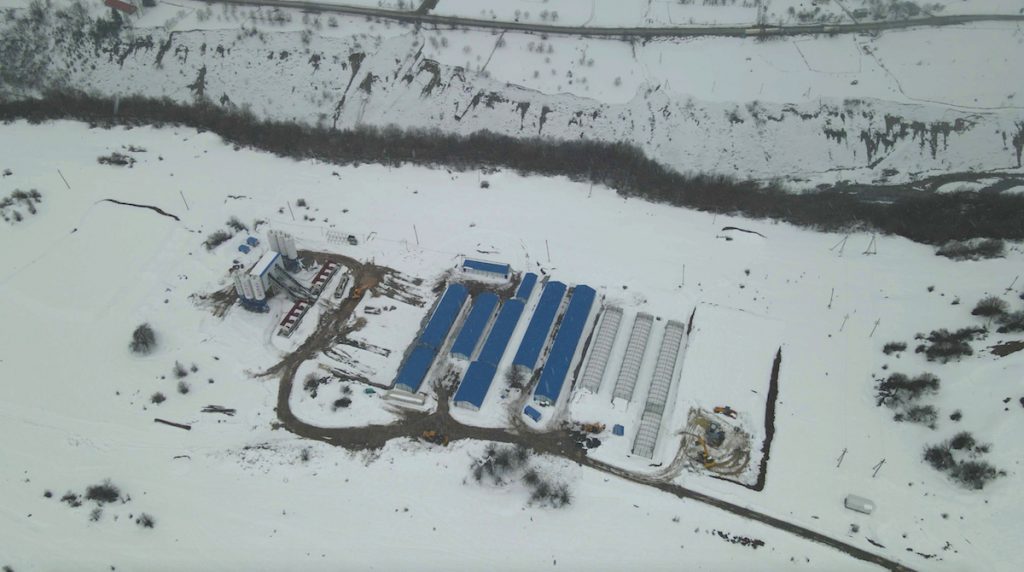
This project has both opponents and supporters in Georgia. The main argument of the opponents is state security.
For some, the new road poses a threat primarily by making it easier for Russia to invade Georgia, as it did in 2008.
For example, ex-President Saakashvili, who himself planned to build a tunnel here, changed his mind after joining the opposition and wrote on Facebook that “this is a new Roki tunnel (a tunnel on the border of South Ossetia and Russia, through which Russian troops) … Russia opens a military path for the quick capture of Tbilisi.”
Former Deputy Secretary of the Security Council Vano Machavariani generally agrees with Saakashvili’s arguments.
“It is important to know who started this project, in whose interests it is, what financial and economic benefits it brings, and most importantly, what risks we may face. The Georgian government still does not have answers to these questions and considers this road to be an exclusively economic or transport project,” says Matchavariani.
Giga Bedineishvili believes that Georgia should use any profitable trade relations with Russia in its own interests, but it is also necessary to assess certain military risks:
“The road must be built, but we must also think about how to protect ourselves in case of danger. This does not mean that we should not build a road or break off commercial relations. On the contrary, we will be able to de-occupy Georgia only when we are economically stronger. Therefore, we must use any profitable trade with Russia to our advantage, but at the same time know how to act in the event of an attack.”
Expert Paata Tsagareishvili says that the construction of the new road will significantly improve tourist flow, although the benefits for freight traffic will be small:
“Traffic for tourists along the old road will, of course, be unloaded, because trucks will only move along the new route. However, the new road is also quite narrow and I doubt it will ease the intense and ever-increasing transit traffic.”
In his opinion, from an economic point of view, the project will not be particularly profitable.
Today, from every foreign heavy truck passing along the Mtskheta-Stepantsminda-Lars route, Georgia receives 200 GEL [about $60], which is about 15-20 million lari [$4.5-6 million] per year, which is barely enough to maintain the roads.
And against this background, the project for the construction of a new section does not seem very profitable to experts.
“In exchange for an investment of $550 million, we must transport wheat to Armenia, which will not bring us such a profit as investments in the development of a deep-water port in Anaklia or a railway could,” says Paata Tsagareishvili.
Giga Bedineishvili, on the other hand, considers it correct to transfer the work of the new road to a commercial basis:
“Instead of borrowing money or borrowing money from taxpayers who do not use this road, it is better for the road to be toll and those who use it pay for it.”
The opinion of experts is also shared by the head of the ecological organization Green Alternative Manana Kochladze:
“We do not have a correct transport policy. We give preference to the development of highways and less load on the railways. We are developing the road not in the interests of Georgia, but in the interests of the region, which in turn is not bad, but there is no analysis of what economic benefits the new road will bring to our country.”
Locals and the road
Local residents generally welcome the construction of the road – primarily because, they say, tourists will be more comfortable coming if the road is not congested.
The population here is not afraid of “Russian tanks”, the fears of people are slightly different.
Elguja Butkhuzi was born in the village of Mleta and lived all his life not far from this road.
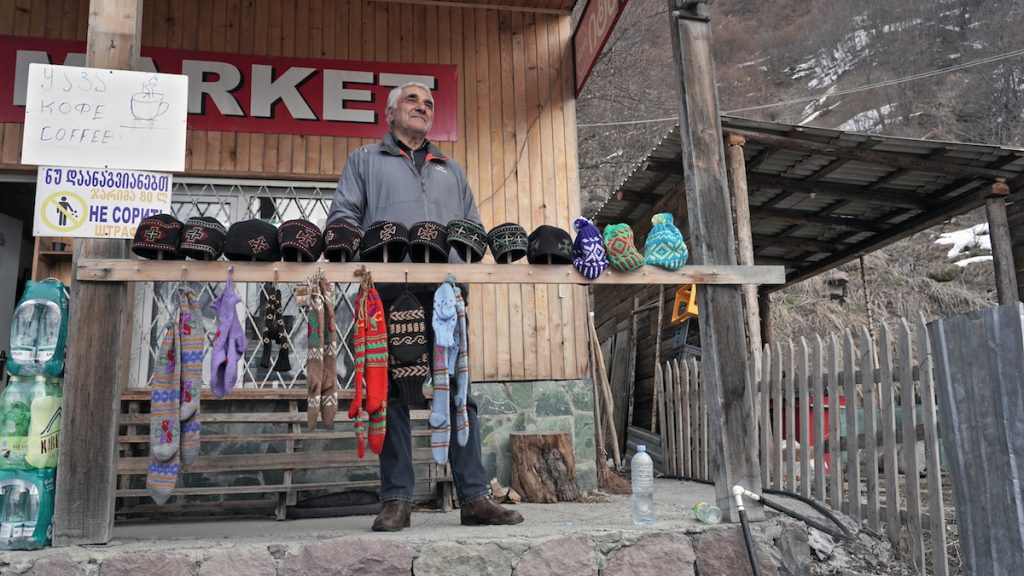
For the past 20 years, his café and small shop on the rise near Mljet have been a favorite place for thousands of travelers to take a break from the tiring road. During the pandemic, his small cafe closed, only the store is open, but now customers are rarely here.
“This road is my earnings. Now that it is closed, no one even comes for cigarettes. When the new road opens, the trucks will go there, and the movement here will be freer. Then tourists can safely go where they need to. The new road will not interfere with us, cars will continue to travel this way. “
Upstairs, practically at the pass, there is the Gudauri resort, a favorite winter recreation place for Georgian residents, popular among foreign tourists. As soon as the tunnel starts working, the resort will get rid of the endless columns and heavy trucks that will go around.
Elguja tells us the story of the Georgian Military Highway, which the Russian Empire built in the 19th century. He remembers that asphalt was first laid on this road in the 60s. At that time he was about 15-16 years old.
“We need Russian tourists,” says Elguja. – If a Russian comes to the store, he will not leave without spending at least 50 lari [about $ 15]. If a Georgian comes in, he will either take something or not. The Russians have more money, what can you do. This road is not dangerous, if someone wants to enter (Georgia), he will enter anyway ”.
In front of the store, several women sell handmade headscarves and accessories. The pandemic, heavy snowfall and a closed road have seriously affected their income.
“Tourists don’t drive anymore, the road is closed, even trucks don’t run anymore. We are sitting here for ourselves, ”says one of them.
Above the village of Mleta is the village of Seturebi. The new Kvesheti-Kobi road will pass through this village.
Badri Seturidze is a local resident dissatisfied with the construction. According to him, the majority of residents are not satisfied with the fact that the new highway will disturb the peace of the village.
“I live in the countryside because I want to live in the country, not in the city. Route routing means there will be dust, dirt, noise, and trouble. We demand that the road bypasses our village ”.
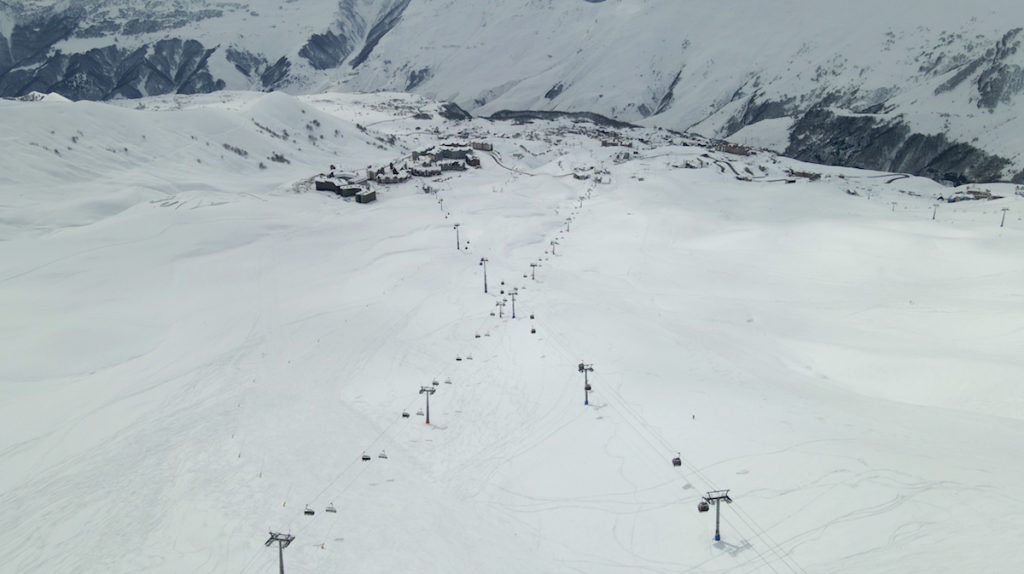
According to a 2020 Green Alternative study, 108 families will lose 10 percent of their agricultural land as a result of the new highway, and also endanger cultural heritage sites in the Hada Valley, known as the Valley of 60 Towers.
Part of the agricultural land of local residents will be cut off by the road, and people will have to detour to get into their own possessions. Badri Seturidze says that some residents are not satisfied with the amount of compensation.
“In recent years, young people have returned here – after tourism began to develop in Gudauri, and now the village will be empty again. For example, I built a house here for one of my sons, but I will not be able to build another one, because there simply will be no room left, ”says Badri.
With the support of “RLNE”


















